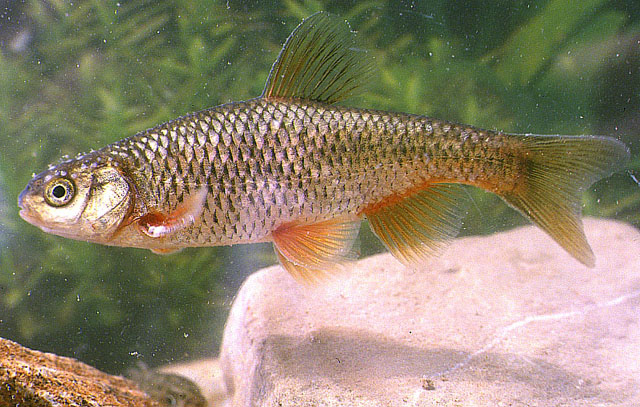| Leuciscidae (Minnows), subfamily: Leuciscinae |
| 18 cm SL (male/unsexed); max. reported age: 6 years |
|
benthopelagic; freshwater; pH range: 7; dH range: 20 |
| Europe: Tyrrhenian slope from Magra to Bussento drainages, Adriatic slope from Chienti to Trigno drainages and Ofanto drainage in Italy. Introduced in southern Italy and Sicily; part of range on Adriatic slope and southernmost localities on Tyrrhenian slope possibly results from introductions. |
|
Dorsal soft rays (total): 11-11; Anal soft rays: 12-12. Formerly placed under Rutilus and cannot be treated under Rutilus and Lecos by the following diagnostic characters: pharyngeal teeth formulae, 5-5; presence of prominent tubercles at the center of each scale of the body and on the head in breeding males; lateral stripe masked by heavy pigmentation on flanks formed by well marked crescent triangular spot on scales; and shape not found in all species of Rutilus and Lecos (Ref. 96829). |
| Inhabits streams with moderate current, shallow, sand or gravel bottom, and limited aquatic vegetation (Ref. 59043). Prefers running waters and is not well adapted in still waters (Ref. 96829). Occurs in groups. Feeds on small molluscs and crustaceans, insects and algae. Spawns in clear, shallow water, on gravel and aquatic vegetation on sunny days (Ref. 59043). Attains a maximum size of about 18 cm SL (Ref. 59043), but reported not to exceed 16 cm SL (Ref. 96829). Threatened due to the introduction of other species and habitat destruction. Can colonize lakes in the absence of specialized lacustrine species (Ref. 26100). |
|
Near Threatened (NT); Date assessed: 31 January 2006 Ref. (130435)
|
| harmless |
Source and more info: www.fishbase.org. For personal, classroom, and other internal use only. Not for publication.

